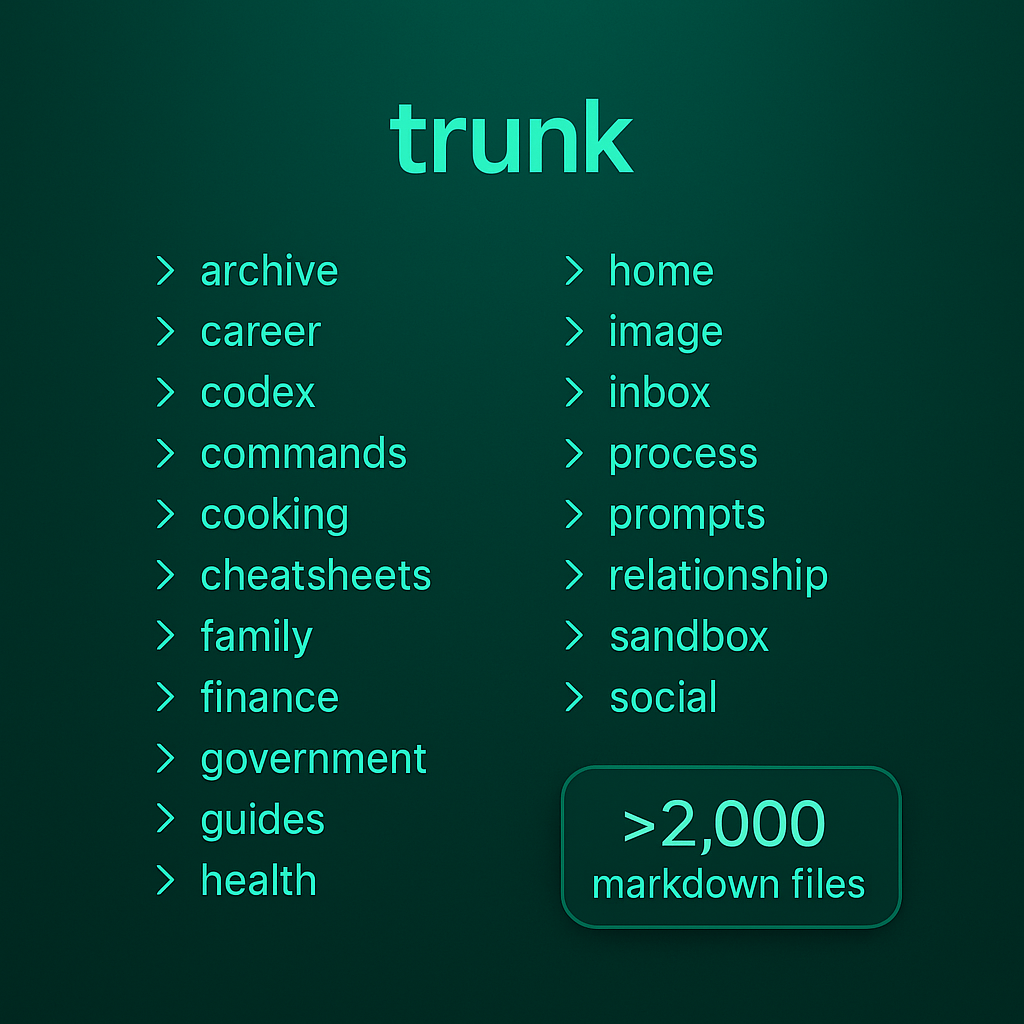Trunk: My Document Repository

I have a massive document repository shared on all of my devices that I call my trunk. Others often call this kind of thing a second brain.
Table of contents
- What's in it
- How its structured
- File names
- Doctypes
- Templates
- What's
${1:QCF}all about? - OK, but what's all
/mnt/c/userscrap?
What's in it
- Markdown files (the vast majority)
- Binary files (e.g.
.pdf,.jpg, etc.) - Config files (e.g.
.code-workspace,.json, etc.)
How its structured
Throughout years of trying to find something that works well for me, I have taken ideas from PARA, Dendron, and even programming frameworks like Rails.
The root of trunk contains the following:
admin/- data extracted from Todoist, the todo list app I usedocs/- markdown and binary filesconfig/- where I keep configuration files that I'd like backed up and shared across all my devices (primarily app settings)
Each folder and subfolder within docs/ represents a collection or a category.
Collections
From PARA
If it makes sense to do so (which isn't always the case), many categories and subcategories use PARA:
projects/- short-term outcome-driven effortsareas/- ongoing aspects with no set end dateresources/- for me, these are just binary filesarchive/- inactive or old files
Logistical collections
inbox/- a temporary holding cell until I figure out where something needs to gotemp/- I hitCtrl+S30 times per minute and sometimes I just want to shove a file somewheretemplates/- used to create files for all the different doctypes I use (only present at the topmost level ofdocs/).
Doctype collections
Within a particular category, if I have a specific doctype for a file, I have a folder for it as well. These include:
cheatsheets/- I know I'm going to want to remember how to do this thing later... better put it somewhere.notes/-meetings/- meeting notes. Often copy/pasted onto a shared platform (e.g. Confluence, Notion, etc.)
Categories
Best explained by example:
family/erica/(my wife)greenfields/(siblings and Mom (Dad passed in 2013))kids/
health/exercise/medical/mobility/nutrition/sleep/
tech/ai/autohotkey/ruby/- (and many others)
File names
Every file name follows the same pattern: <doctype>.<details>.<extension>.
Punctuation:
.: separate concepts_: separate words-: denotesandorto
Examples
template.pr_title-body.md- a template for writing a pull request (PR) title and bodyjournal.3_6_2025.md- a journal entry for March 6th, 2025comms.2_1_2025.preschool_tuition.erica.md- a text message on February 1st, 2025 about preschool tuition to send to Erica
Why do I do it this way?
- I start with the doctype to make fuzzy searching for a file easier. If I want to open my Ruby cheatsheet and I type
ruby, I get a ton of other files I don't want. But if I typecheat ruby, thencheatsheet.ruby.mdis the first hit. - When navigating a file name my word or part, most apps and operating systems will jump over
_but not-or.. This gives you more granular control when renaming files - There were other characters I wanted to use instead, but these 3 punctuation are the only ones that are valid across Mac, Linux, and Windows
Doctypes
I use doctypes for markdown and binary files alike. In family/kids/teagan/preschool/tuition/, I have receipt.3_1_2025.pdf and invoice.3_1_2025.pdf.
Templates
The vast majority of the time, I create files in VSCode/Cursor. This means that my templates are stored as snippets in JSON. For example, this is my notes template stored in the markdown.json snippet configuration within VSCode/Cursor:
"Notes template": { "prefix": "notes-template", "body": [ "---", "Description: ", "Created: ${1:QCF}", "---", "/mnt/c/users/omgreenfield/desktop/matts/trunk/docs/notes.${2:DETAIL}.md", "- [📚 Refs](#-refs)", "- [✅ Action items](#-action-items)", "- [📒 Notes](#-notes)", "- [💻 Ruby sandbox](#-ruby-sandbox)", "", "# 📚 Refs", "", "- TBD", "", "# ✅ Action items", "", "- [ ] TBD", "", "# 📒 Notes", "", "- TBD", "", "# 💻 Ruby sandbox", "", "```ruby", "", "```", ], "description": "Adds template for a generic note" }
Editing this directly is a pain in the butt. Instead, I keep the actual template here: trunk/docs/templates/template.notes.md.
When I make changes to it, I do a quick series of key presses to translate the markdown in snippet JSON.
NOTE: I'm aware that there are easier ways of managing my snippets, but I didn't like them, I don't have any issues with my current system, and I haven't made the switch just yet.
What's ${1:QCF} all about?
In VSCode snippets, you can put placeholders that can be tabbed through. When I insert this template, the text QCF is automatically selected. If I hit Tab, then DETAIL is selected
I have a lotttttttttt of hotstrings. Most of them start with q since it's easy to press with my left hand and words in English always have a u afterwards. QCD is "current date" (3/6/2025), QCT is "current time" (19:53), and QCF is "current... full" (Thursday, 3/6/2025 @ 19:53)
Hotstrings are only triggered when typed lowercase, so when I'm editing a template, I can type them in uppercase without being harassed, and I don't have to think about which hotstring to type, I just type the keys I see.
OK, but what's all /mnt/c/users crap?
I often need to create new markdown files while I'm writing code. If I was just looking at a model in a Rails project, then create and save a new file, it will start me in the app/models/ folder. But since I often keep the same kind of files in the same folder, I have found that just putting the absolute path at the top makes it much easier to save the files where they need to go.
My desktop is on Windows (because AutoHotkey doesn't exist on Mac or Linux), but a lot of development works better on Unix machines. I do all of my development on Ubuntu through WSL, but the trunk lives on Windows
Sure, but desktop/matts/trunk/?
I think I made that matts folder when I was a teenager and just haven't stopped using it since 🤷♂️.